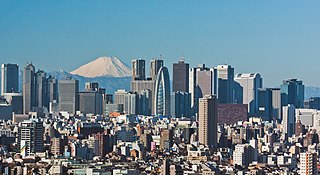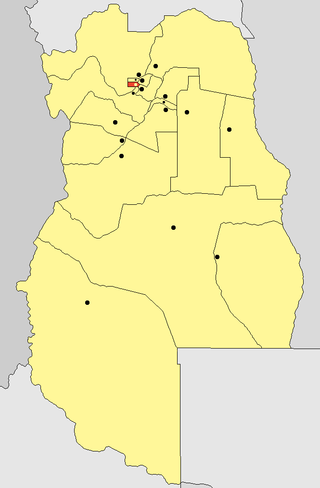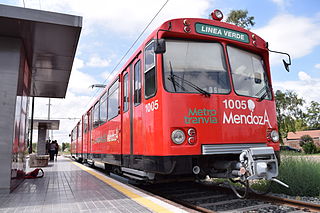Related Research Articles

Transport in Argentina is mainly based on a complex network of routes, crossed by relatively inexpensive long-distance buses and by cargo trucks. The country also has a number of national and international airports. The importance of the long-distance train is minor today, though in the past it was widely used and is now regaining momentum after the re-nationalisation of the country's commuter and freight networks. Fluvial transport is mostly used for cargo.

Mendoza, officially Province of Mendoza, is a province of Argentina, in the western central part of the country in the Cuyo region. It borders San Juan to the north, La Pampa and Neuquén to the south, San Luis to the east, and the republic of Chile to the west; the international limit is marked by the Andes mountain range. Its capital city is the homonymous city of Mendoza.

A conurbation is a region comprising a number of metropolises, cities, large towns, and other urban areas which through population growth and physical expansion, have merged to form one continuous urban or industrially developed area. In most cases, a conurbation is a polycentric urbanised area in which transportation has developed to link areas. They create a single urban labour market or travel to work area.

Mendoza, officially the City of Mendoza is the capital of the province of Mendoza in Argentina. It is located in the northern-central part of the province, in a region of foothills and high plains, on the eastern side of the Andes. As of the 2010 census [INDEC], Mendoza had a population of 115,041 with a metropolitan population of 1,055,679, making Greater Mendoza the fourth largest census metropolitan area in the country.

The State of Mérida commonly known simply as Mérida is one of the 23 states of Venezuela. The state capital is Mérida, in the Libertador Municipality.

Rosario is the largest city in the central Argentine province of Santa Fe. The city is located 300 km (186 mi) northwest of Buenos Aires, on the west bank of the Paraná River. Rosario is the third-most populous city in the country, and is also the most populous city in Argentina that is not a capital. With a growing and important metropolitan area, Greater Rosario has an estimated population of 1,750,000 as of 2020. One of its main attractions includes the neoclassical, Art Nouveau, and Art Deco architecture that has been retained over the centuries in hundreds of residences, houses and public buildings.

Greater Buenos Aires, also known as the Buenos Aires Metropolitan Area, refers to the urban agglomeration comprising the Autonomous City of Buenos Aires and the adjacent 24 partidos (districts) in the Province of Buenos Aires. Thus, it does not constitute a single administrative unit. The conurbation spreads south, west and north of Buenos Aires city. To the east, the River Plate serves as a natural boundary.

An urban area, built-up area or urban agglomeration is a human settlement with a high population-density and an infrastructure of built environment. This is the core of a metropolitan statistical area in the United States, if it contains a population of more than 50,000.

La Matanza is a partido located in the urban agglomeration of Greater Buenos Aires, Buenos Aires Province, Argentina.

Club Deportivo Godoy Cruz Antonio Tomba, known simply as Godoy Cruz, is an Argentine sports club from Godoy Cruz, Mendoza. The club is best known for its football team, that plays in the Primera División, the top level of the Argentine football league system.

The Barcelona-Puerto La Cruz Metropolitan Area, better known as Greater Barcelona, is a Venezuelan conurbation formed by the localities of Barcelona, Puerto La Cruz, Guanta and Lecheria, forming one of the largest metropolitan areas of the country. Although the state's public powers are in Barcelona, its economic, social and political activities exceed its geographical limits without forming a formally established political division. It has a population of 801,071 inhabitants, being the biggest urban agglomeration in the North-Eastern Region, and the 7th in Venezuela.

Godoy Cruz is a central department of Mendoza Province in Argentina.

Guaymallén is a central department of Mendoza Province in Argentina.

Méier is a middle class and upper middle class neighborhood in the North Zone of Rio de Janeiro, Brazil. The neighborhood is the historic center of the "Área dos Engenhos", or "Mill Area", which today is known as Grande Méier and has been a sub-prefecture since 2013. As a result, it has a wide range of shops and a variety of services and transport, although it is not one of the largest neighborhoods of the municipality. In the neighborhood is located one of the first shopping centers in Brazil, Shopping do Méier, opened in 1963. It has two distinct urban appearances, one more bustling, commercial, in the areas close to the train station, and a quieter one, on more residential streets.

The Metrotranvía Mendoza is a public light rail transport system for the city of Mendoza, Argentina, served by articulated light rail cars operating on newly relaid tracks in former-General San Martín Railway mainline right-of-way.

Juan Alejandro Abaurre is a former Argentine footballer who played as a forward for clubs in Argentina, Switzerland and Chile.

The Mendoza trolleybus system formed part of the public transport network in Mendoza, the capital city of Mendoza Province, Argentina. It is owned by the provincial government.

Vecindario is a town in the municipality of Santa Lucía de Tirajana in the south-eastern part of the island of Gran Canaria, in the Province of Las Palmas, in the Canary Islands. The population of Vecindario was estimated at about 14910 inhabitants in the 2015 census. Its current mayor is Dunia Gonzalez.
References
- ↑ "Annual Estimates of the Censo 2008 - Resultados provinciales Mendoza". INDEC. 2008. Archived from the original on 2011-05-20. Retrieved 2010-07-24.